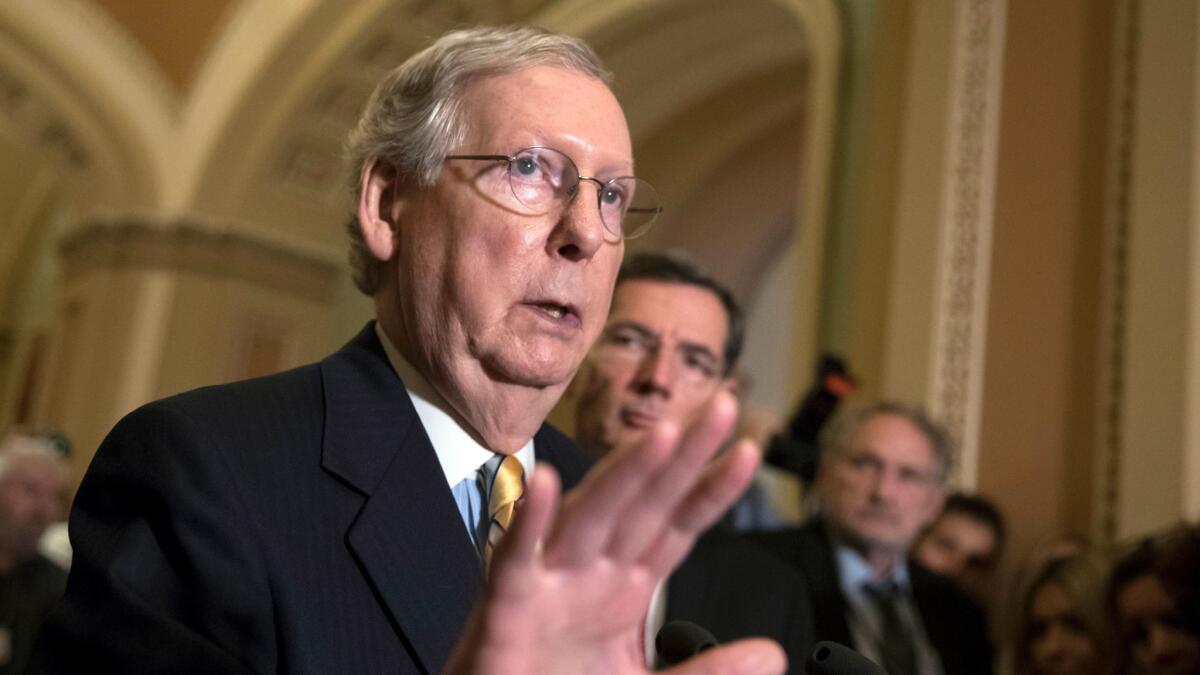Column: As GOP moves toward repeal, a government report shows Obamacare is working well

- Share via
New data have been released contradicting Republican propaganda about the “failing” Affordable Care Act. What may be more embarrassing to the hardliners pushing repeal is that it comes from the government, specifically the Department of Health and Human Services.
Under Secretary Tom Price, the department has been a fount of anti-ACA rhetoric. But in an annual report about the ACA’s risk-management provisions issued Friday, Health and Human Services established that the key programs are “working as intended,” protecting insurers from unexpectedly large risks and moderating premiums for consumers.
Not only that, the data “would seem to refute the commonly held belief that the marketplace population is becoming sicker,” observes health economist Timothy Jost, writing in Health Affairs. In fact, according to the figures from 2016 in the latest report, the customer base is getting healthier and the risk pools have been stabilizing.
Both the transitional reinsurance program and the permanent risk adjustment program are working as intended.
— Department of Health and Human Services
The report covers the ACA’s permanent risk adjustment program and its temporary reinsurance program, which ran from 2014 through the end of last year and then expired.
The first program imposes a charge on plans with lower average risks and transfers those funds to the higher-risk plans. It’s designed to be neutral within each state, and the HHS data show that’s exactly what has happened. Among California’s 15 eligible insurance carriers, about $392.7 million appears on both sides of the ledger for 2016.
The idea of risk adjustment is to remove the incentive for insurers to cherry-pick healthy customers. Although the ACA requires that insurers in the individual market sell insurance to all applicants without surcharging them for pre-existing conditions or their medical histories, there are many ways for insurers to discourage sicker patients from signing up — for instance, they can drop certain drugs from their prescription formularies or assemble narrow physician networks that skimp on certain specialties. Thanks to risk-adjustment, the more successful such plans are in achieving low-risk enrollment pools, the more they’ll get dinged for a payment each year.
Reinsurance was designed to protect insurers from individual high-cost enrollees. It was limited to the first three years of the individual exchanges, 2014-16, on the reasoning that by the end of that period insurers would have enough experience and sufficiently large customer bases to cover high-cost outliers without assistance. The provision was to pay out $20 billion to insurers via assessments on the industry over its three-year life. Payment requests came to about $7.5 billion for 2016.
Programs like these are anything but novel. They’re permanent features of Medicare Part D, the prescription drug program that was championed by Republican lawmakers when it was enacted in 2003. Part D also includes a risk-corridor provision, which places an assessment on insurers collecting large profits from the program and pays them out to insurers with commensurate losses.
The ACA also has a risk-corridor provision, but it was seriously hamstrung by congressional Republicans, who suddenly decided that it was an insurer “bailout” even though they wrote it into their Part D legislation. We’ve reported before on the flagrant hypocrisy of this act (we’re looking at you, Marco Rubio, R-Fla.), which merely drove up costs for consumers.
But Jost correctly observes that the risk management programs have worked, as is documented in Friday’s HHS report and the previous annual surveys. In 2016, reinsurance is estimated to have reduced net claim costs by 4%-6%. Its termination, Jost writes, “has been a major driver of premium increases for 2017 and 2018.” As a result, both the House and Senate Obamacare repeal bills include more reinsurance funds for the individual market.
The conclusions in the Department of Health and Human Services report confirm that the ACA marketplace was stabilizing through 2016, despite GOP claims to the contrary. In fact, the marketplace did better than expected.
“There were a number of reasons to believe that risk scores would be higher for the 2016 benefit year relative to the 2014 benefit year,” HHS reported. Among other factors, the average enrollee spent more months on the exchanges in 2016 than in previous years. That typically leads to higher claims, because it produces “increased numbers of reported diagnoses, higher risk scores, and greater paid claims amounts per member, even when the risk profile of the membership is held constant…. Despite these factors, risk scores were stable in the individual market and decreased by 4 percent in the small group market.”
What will the ACA’s enemies in Congress, the White House, and the office of HHS Secretary Tom Price make of this report, since it gives the lie to the argument that Obamacare is in a “death spiral” (House Speaker Paul Ryan, R-Wisc.)? The betting here is that if they can’t distort its findings to say the opposite of what’s there in black and white, then you won’t be hearing much about it at all.
So far, that’s the case: Price, who was last heard praising the Senate GOP’s incompetent and malevolent Obamacare repeal bill, has been silent on his own agency’s data showing that Obamacare is working as designed, and that it’s helping Americans get healthier and stay that way.
Keep up to date with Michael Hiltzik. Follow @hiltzikm on Twitter, see his Facebook page, or email michael.hiltzik@latimes.com.
Return to Michael Hiltzik’s blog.
MORE FROM MICHAEL HILTZIK:
Republicans say Medicaid doesn’t work, so it should be cut. Here are all the ways they’re wrong
Port truckers who carry your favorite goods to market are being cheated to save you money
That new Seattle study is a big problem for fans of a higher minimum wage — or is it?
More to Read
Inside the business of entertainment
The Wide Shot brings you news, analysis and insights on everything from streaming wars to production — and what it all means for the future.
You may occasionally receive promotional content from the Los Angeles Times.











